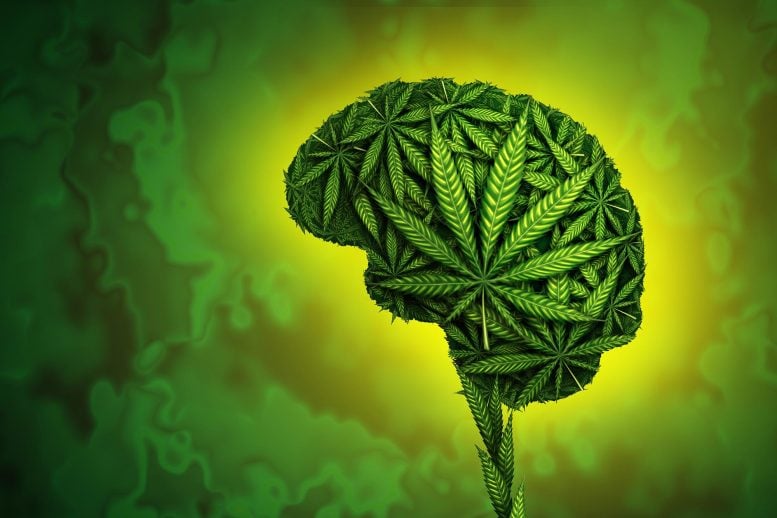
New analysis exhibits that self-medicating with cannabis can lead to higher paranoia, anxiety, and depression—especially for those with childhood trauma.
Recreational users face fewer risks, but those coping with pain or distress tend to consume more THC and struggle more with mental health.
Rising Cannabis Use and Mental Health Concerns
A major study led by the Institute of Psychiatry, Psychology & Neuroscience (IoPPN) at King’s College London, working with the University of Bath, has revealed that a person’s reasons for using cannabis can play a major role in whether they later develop paranoia.
As cannabis becomes stronger and more widely used across the globe, cases of dependence and cannabis-induced psychosis have been rising, with particularly sharp increases reported in North America. Drawing on data from Cannabis & Me (the largest survey of its type), two new studies have pinpointed important risk factors linked to the most severe forms of paranoia in people who use cannabis.
Exploring Motives Behind First Cannabis Use
The first study, published in BMJ Mental Health, examined how people’s initial reasons for using cannabis influenced their long-term patterns of use.
A total of 3389 adults, both current and former cannabis users aged 18 and above, completed a survey. They were asked about their motivations for starting and continuing cannabis use, how much they consumed each week in THC units, and their overall mental health.
The results revealed a clear pattern. Participants who first turned to cannabis as a way of coping with physical pain, anxiety, depression, or early psychotic symptoms scored significantly higher for paranoia.
By contrast, those who initially used cannabis out of curiosity, for enjoyment, or in a social setting with friends reported the lowest levels of paranoia and anxiety.
Expert Warnings on Cannabis and Mental Health
Dr. Edoardo Spinazzola, a Research Assistant at King’s IoPPN and the study’s first author, said, “Our study provides vital evidence on how the reason someone first starts using cannabis can dramatically impact their long-term health.
“This research suggests that using cannabis as a means to self-medicate physical or mental discomfort can have a negative impact on the levels of paranoia, anxiety, and depression. Most of these subgroups had average scores of depression and anxiety, which were above the threshold for referral to counselling.”
Measuring THC Consumption Patterns
Respondents were also asked to provide data on the frequency and strength of the cannabis they were using so that researchers could track their average weekly consumption of Tetrahydrocannabinol (THC) – the principal psychoactive component of cannabis.
The researchers found that the average respondent consumed 206 units of THC a week. This might equate to roughly 10-17 ‘joints’ per week, if the user was consuming an expected 20 percent THC content that is standard for the most common types of cannabis available in London.
However, respondents who started using cannabis to help with their anxiety, depression, or in cases where they started due to others in their household who were already using cannabis, reported on average 248, 254.7, and 286.9 average weekly THC units, respectively.
Comparing Cannabis to Alcohol Units
Professor Tom Freeman, Director of the Addiction and Mental Health Group at the University of Bath and one of the study’s authors, said, “A key finding of our study is that people who first used cannabis to manage anxiety or depression, or because a family member was using it, showed higher levels of cannabis use overall.
“In the future, standard THC units could be used in a similar way to alcohol units – for example, to help people to track their cannabis consumption and better manage its effects on their health.”
Childhood Trauma, Paranoia, and Cannabis Use
In a separate study, published in Psychological Medicine, researchers explored the relationship between childhood trauma, paranoia, and cannabis use.
Researchers used the same data set from the Cannabis & Me survey, with just over half of respondents (52 percent) reporting experience of some form of trauma.
Types of Abuse and THC Consumption
Analysis established that respondents who had been exposed to trauma as children reported higher average levels of paranoia compared to those who hadn’t, with physical and emotional abuse emerging as the strongest predictors.
Researchers also explored the relationship between childhood trauma and weekly THC consumption. Respondents who reported experiencing sexual abuse had a markedly higher weekly intake of THC, closely followed by those who reported experiencing emotional and physical abuse.
Finally, the researchers confirmed that the strong association between childhood trauma and paranoia is further exacerbated by cannabis use, but is affected by the different types of trauma experienced. Respondents who said they had experienced emotional abuse or household discord[1] have been strongly related to elevated THC consumption and paranoia scores. Respondents reporting bullying, bodily abuse, sexual abuse, bodily neglect, and emotional neglect, however, didn’t present the identical results.
Medical Implications of the Findings
Dr. Giulia Trotta, a Marketing consultant Psychiatrist and Researcher at King’s IoPPN and the examine’s first writer, stated, “This complete examine is the primary to discover the interaction between childhood trauma, paranoia, and hashish use amongst hashish customers from the overall inhabitants.
“We now have not solely established a transparent affiliation between trauma and future paranoia, but additionally that hashish use can additional exacerbate the consequences of this, relying on what type the trauma takes.
“Our findings could have clear implications for medical apply as they spotlight the significance of early screening for trauma publicity in people presenting with paranoia.”
Coverage Issues Round Legalization and Dangers
Professor Marta Di Forti, Professor of Drug use, Genetics and Psychosis at King’s IoPPN, Medical Lead on the South London and Maudsley NHS Basis Belief’s Hashish Clinic for Sufferers with Psychosis, and the senior writer on each research, stated, “There may be in depth nationwide and worldwide debate concerning the legality and security of hashish use.
“My expertise within the clinic tells me that there are teams of people that begin to use hashish as a method of dealing with bodily and emotional ache. My analysis has confirmed that this isn’t with out vital additional threat to their well being and wellbeing, and coverage makers the world over needs to be aware of the influence that legalization, with out enough public training and well being assist, may have on each the person, in addition to on healthcare techniques extra broadly.”
Notes
- Family discord refers to residing in an area the place there may be disharmony, battle, or disagreement inside a household unit.
References:
“Are causes for first utilizing hashish related to subsequent hashish consumption (normal THC items) and psychopathology?” by Edoardo Spinazzola, Hannah Degen, Isabelle Austin-Zimmerman, Giulia Trotta, Edward Chesney, Zhikun Li, Luis Alameda, Bok Man Leung, Yifei Lang, Andrea Quattrone, Diego Quattrone, Erika Castrignanò, Kim Wolff, Robin Murray, Tom P Freeman and Marta Di Forti, 26 August 2025, BMJ Psychological Well being.
DOI: 10.1136/bmjment-2025-301810
“The influence of childhood trauma and hashish use on paranoia: a structural equation mannequin method” by Giulia Trotta, Edoardo Spinazzola, Hannah Degen, Zhikun Li, Isabelle Austin-Zimmerman, Bok Man Leung, Yifei Lang, Victoria Rodriguez, Monica Aas, Lucia Sideli, Kim Wolff, Tom P. Freeman, Robin M. Murray, Chloe C. Y. Wong, Luis Alameda and Marta Di Forti, 8 August 2025, Psychological Drugs.
DOI: 10.1017/S0033291725101190
Hashish & Me was attainable due to funding from the Medical Analysis Council (MRC).
By no means miss a breakthrough: Join the SciTechDaily newsletter.














